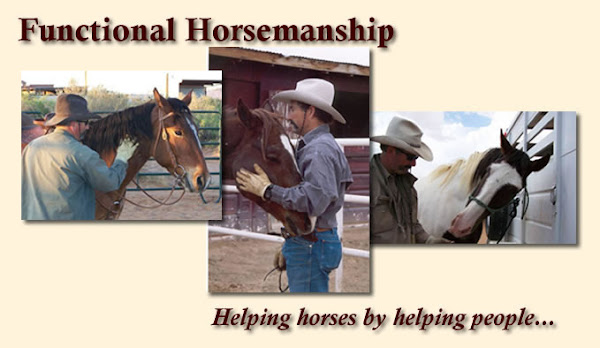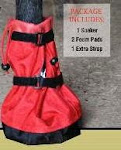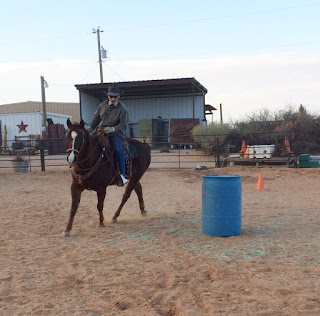There is an old saying that working a fresh horse or a horse who has a tendency to buck in the round pen or on a lunge line won't take the buck out of him. There's a large amount of truth in this as if a horse wants to buck, he will. Besides why would someone intentionally get a horse who bucks until they get alot of that nonsense out of him. Melanie wrote in with the question: "I ride my horse mostly on weekends so by the time I take him out of his stall he has a bunch of pentup energy from being in his stall. I've been advised to round pen him to take the energy out of him but not only just this seem not to work very well, it takes away from my riding time. What else can I try to do? "
Melanie did not say how her horse demonstrates excess energy. It doesn't sound like her horse bucks or runs off with her, so I suspect that she needs her horse to look to her more as the leader. And warming him up before you rides can serve both - bleeding of some energy and getting him focused on you. Sure, penning up young horse, or really any horse, for days on end is likely to make him want to go someplace. And depending upon what you are feeding him - that could contribute a little bit as well. But it's all going to come back to Melanie making herself the senior partner in this relationship.
Working a horse in a round pen before you ride him can help take the freshness out of him but it is really what you do and how you do it that will make the difference. Before you get him into the round pen, you can do things with him in a halter and lead to get him listening and looking to you. If he crowds you when you get in the stall, move him off; make him drop his head so you can get the halter on; if he gets distracted, bump him back to focus on you; you may want to go 15-20 seconds of lateral flexion while on the ground, before you move off; gets his front and back ends to disengage independently; as you lead him off see how little feel or change of weight in the lead line it takes to get him to move his feet; make him lead up correctly; stop him, back him again on as little pressure as it takes, but a much as you need.
All of this is reminding him that you are the leader. You can think of these things as pre-ride checks. I do them all of the time, every time. It also helps me gauge where the horse's mind is - they have bad days too you know.
All of this is reminding him that you are the leader. You can think of these things as pre-ride checks. I do them all of the time, every time. It also helps me gauge where the horse's mind is - they have bad days too you know.
The purpose of working a high energy horse in a round pen or on a lunge line before you ride him is not only to bleed off some of that energy, but more importantly to get the horse responding to you, seeing you as the leader. You do that by moving his feet, not by just letting him move around at whatever speed and direction he wants. This is important. As I help riders correct things like a horse drifting of as they mount or really most bad habits you can think of, I have them move the horse's feet. Almost everytime in the beginning, it's like the rider is just meekly asking the horse to move...... you need to think of it as insisting that they move their feet.
Rider's who previously kind of passively handled their horses will see an immediate change in their horses as they start insisting on things. Sometimes you may get an initial dose of resentment, but they are just trying to figure out if you really mean it and if they have to do it. Same as in a corral with other horses. You'll see ears pinned, teeth showing, necks stretched out and one of the horses will move.
Almost everytime I ride, I'll warm a horse up. In the round pen free lunging, or on a lunge line or using the lead line of my mecate reins. This serves to warm the horse up and let me look for any elements of discomfort and lameness, and also gets that horse looking to me for direction. I change direction often; I'll bump them on the lead if they distracted with something else; I have them stop and roll the back end back over (disengage the backend); I'll have them face me up and back up on vibration or slight shaking of the lead line; and, I will have them change speeds. And in everything, I try to work on as subtle as a signal as I can. Start as soft as you can, but use as much pressure as you need to, otherwise that horse is going to learn, and you can't blame him, that he doesn't have to comply or just comply with the least amount of effort. Kinda like your children when you get them to police up wind blown trash along a fence line.
Lastly, if your horse is high energy under saddle, then re-direct that energy doing something. Make him move his feet. Back him with energy. Do circles. Double him against a fence. I think if you try all of the above you'll see a big difference, but understand being penned up for days on end is not the best thing for him mentally. Good luck Melanie and let me know how you are doing.
















